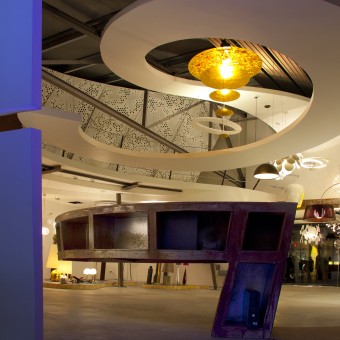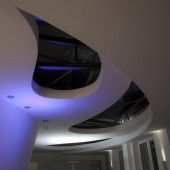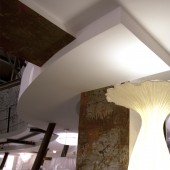
| THE AWARD |
| CATEGORIES |
| REGISTRATION |
| SUBMIT YOUR WORK |
| ENTRY INSTRUCTIONS |
| TERMS & CONDITIONS |
| PUBLICATIONS |
| DATES & FEES |
| METHODOLOGY |
| CONTACT |
| WINNERS |
| PRESS ROOM |
| GET INVOLVED |
| DESIGN PRIZE |
| DESIGN STORE |
| THE AWARD | JURY | CATEGORIES | REGISTRATION | PRESS | WINNERS | PUBLICATIONS | ENTRY INSTRUCTIONS |
Light Design Center Speyer, Germany Lighting Exhibition and Shop by Peter Stasek |
Home > Winners > Design #25404 >Interview |
 |
|
FS: What is the main principle, idea and inspiration behind your design?
PS: The showroom of the new Light Center Speyer, situated in a factory building, was to be designed as exhibition space, consulting area and meeting place. Here, a frame generating interior design synergy effects was to be created for all latest light trends, technologies and light designs.
FS: What has been your main focus in designing this work? Especially what did you want to achieve?
PS: Its sophisticated structure was to build the backbone of the entire light exhibition, but at the same time was never to overshadow the priority of the lighting objects to be exhibited. For this purpose, nature created a unifying shape as inspiration: the „twister“, a natural phenomenon with invisible forces which make nearly everything float and which, at the same time, cause new aesthetics of spiral sailing. The maelstrom of the twister, a polarizing force, magically draws almost every visitor into the middle of the exhibition and makes them, together with all the high-end light objects, completely forget the existing gravity.
FS: What are your future plans for this award winning design?
PS: Twister remains as a sign of the accentuation of the center of a room or an urban development area so that this design principle can also be used in many other projects
FS: How long did it take you to design this particular concept?
PS: To construct and realize over 6 months.
FS: Why did you design this particular concept? Was this design commissioned or did you decide to pursuit an inspiration?
PS: At the beginning was the commissioning of the design of the new light center The design idea was created according to the definition of spatial use
FS: Is your design being produced or used by another company, or do you plan to sell or lease the production rights or do you intent to produce your work yourself?
PS: no
FS: What made you design this particular type of work?
PS: The organically shaped 3D twister sculpture, which is floating in the air, marks the middle of the showroom together with the reception desk made from rusted steel. Both adapt themselves to the spiral upwards movement of the twister. This movement already begins within the 2D floor covering design. The shear walls which are tangent to the twister are aligned to the organic lines of the twister just as the whole shape of the intermediate ceiling with steel columns and the layout of the sails above the gallery.
FS: Where there any other designs and/or designers that helped the influence the design of your work?
PS: no
FS: Who is the target customer for his design?
PS: Shops and Shopping Malls
FS: What sets this design apart from other similar or resembling concepts?
PS: When creating an organically shaped sculpture out of a geometric space, you always have to master the connection points
FS: How did you come up with the name for this design? What does it mean?
PS: The Twister is a natural phenomenon with invisible powers that bring almost everything to life while creating a new aesthetics of the spiral sail. This appearance should be regarded as "the internalization of the lightness of being" and should form the backbone of the entire exhibition.
FS: Which design tools did you use when you were working on this project?
PS: imagination drawings photoshop
FS: What is the most unique aspect of your design?
PS: The twister is almost 30m long.
FS: Who did you collaborate with for this design? Did you work with people with technical / specialized skills?
PS: A special challenge here was the construction of the twister made of plasterboard.
FS: What is the role of technology in this particular design?
PS: The substructure and almost invisible suspension of the twister
FS: Is your design influenced by data or analytical research in any way? What kind of research did you conduct for making this design?
PS: no
FS: What are some of the challenges you faced during the design/realization of your concept?
PS: The coordination of the realization in compliance with the budget
FS: How did you decide to submit your design to an international design competition?
PS: To show my conception of shop design.
FS: What did you learn or how did you improve yourself during the designing of this work?
PS: It was a very interesting experience with a longer development phase using several architectural models.
FS: Thank you for providing us with this opportunity to interview you.
A' Design Award and Competitions grants rights to press members and bloggers to use parts of this interview. This interview is provided as it is; DesignPRWire and A' Design Award and Competitions cannot be held responsible for the answers given by participating designers.
| SOCIAL |
| + Add to Likes / Favorites | Send to My Email | Comment | View Press-Release | Translations |





